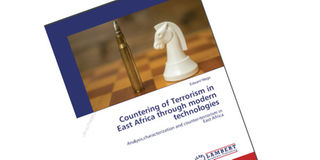Alternative approaches to fighting terror in East Africa

The term “Terrorism” cannot be easily defined because it is context specific. There are over 100 definitions attempting to explain what terrorism simply means. It is important to note that Kurd, Lebanese, Palestinian, Somali, and Kashmir communities view their fighters as freedom fighters, not terrorists. The political nature of terrorism and the challenges of defining it are further exemplified in the case of Hezbollah.
Nonetheless, there is a consensus that terms terrorism as the threat or the act of politically motivated violence directed primarily against civilians. As espoused by eminent Prussian war theorist Carl von Clausewitz, “War is a continuation of policy by other means”.
The implication is that while people join terrorist groups for various reasons, terrorism itself has greater political goals. Terrorist groups develop secular and religious ideologies or belief systems to politicize, radicalize, and mobilise their actual and potential followers.
This is explicit in the activities of groups such as Al-Shabaab, the Islamic State (ISIS), Boko Haram, and Al-Qaeda, to mention but a few.
Furthermore, terrorists disregard the law of armed conflict. They utilise the scheme of targeting civilians as a means of causing and spreading fear, chaos and confusion.
As employed by non-state actors, terrorism is a revolutionary strategy that seeks to influence and disrupt political systems and to overthrow governments. Within the region of East Africa, the largest and most common terror cluster operational is Al-Shabab, which has chiefly established bases in Somalia since 2006. This has spilled over to neighbouring countries as a result.
Al-Shabab emerged as one of the radical youth wings of Somalia’s now-defunct Union of Islamic Courts. Terrorists have become more agile and sophisticated in a way that they have turned to activities involving cyber-attacks attempting to expose, alter, disable, destroy, steal or gain unauthorised access to or make unauthorised use of an asset.
These attacks are typically intended to disrupt the proper functioning of their targets, and include, but are not limited to: computer information systems, servers, networks or underlying infrastructure, through the use of hacking, distributed denial of service, advanced persistent threat techniques, computer viruses, malware, other means of unauthorized or malicious access such as pharming or phishing.
As Most African countries struggle to crack down on cybercrime, mainly due to budgetary concerns and poorly trained staff, making the war against cybercrime in the financial sector particularly challenging and arduous, cyberattacks have thus transformed and bear the characteristics of an act of terrorism, including the inherent desire to instil fear or to advocate for political or social objectives.
The role of technology has thus become imperative in guiding and policing activities, as it provides law enforcement authorities (LEAs) with a set of tools able to strengthen their analytical and investigative skills hence expanding their capacity to handle huge amounts of data, deriving from monitoring and surveillance operations.
This is particularly true when dealing with counterterrorism (CT), as intelligence agencies and other competent agencies are required to put greater attention on tracking terrorist financing, monitoring propaganda activities and the dissemination of training materials, both on the Surface Web, Deep Net and Dark Web whilst keeping in mind other priorities.
This can be considered as the starting point, upon which a systematic project is built and elaborated a set of recommendations for law enforcement intelligence and investigation practices on the Web. The book hence analyses regional counter terrorism strategies and the role of modern technologies in relation to this.
It provides insight into the current security challenges that are bedeviling the East African region. Emphasis is taken on the ending of terrorism extremism and different conflicts especially in the region where it has been a challenge because of its complex multi-causal factors, such as; multiple actors and the nature of the conflict which often contribute to prolonged conflict.
There is, therefore, a need for coordinated efforts of State and Non-State actors, improved analysis and proactive activities if there is to be an effective defeat of not only terrorists but terrorism, as a whole.
This book therefore, will aim at identifying and analysing those factors and creating an integrated system that can curb terrorist activities online within the region. Terrorist characteristic building model processes are thus utilised.
This book further attempts to propose measures to combat terrorism by analysing and identifying criminal activity in East Africa, and offers a set of tools for various stakeholders, such as policy makers and law enforcement agencies, that can strengthen their analytical and investigative skills, thereby enhancing their ability to process the vast amounts of data generated by monitoring and surveillance.
This is crucial for understanding terrorism in East Africa, the specifics and complexity of terrorist acts, and how to counter terrorist activities using modern technologies.
Various types of modern technologies that will focus on the use of artificial intelligence, “big data” and expertise are considered, as well as how they will be used in connection with the obtained probabilistic and estimated risk models to prevent criminal activity. A combination of models and hypotheses is used. Literature analysis, computational analysis and data analysis are also carried out in connection with the analysis of various theoretical works of domestic and foreign authors on information security, artificial intelligence, terrorism and extremism.




